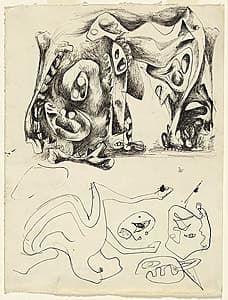

Jackson Pollock
Learn moreUntitled c.1943
© Pollock-Krasner Foundation. ARS/Copyright Agency Purchased 1986
More detail | PermalinkJackson Pollock was a patient of the Jungian psychologist Joseph Henderson: a treatment that coincided with the artist’s growing interest in Surrealism, and a concurrence of events that resulted in a creative outpouring. Between 1938 and 1943, Pollock produced numerous pictographic drawings based on striking symbolic motifs, including a cache of 83 drawings provided to Henderson as material for analytical aids.
The artist’s striking division of the composition Untitled c#1943 into two distinct levels can be interpreted along Jungian lines. The top section—rendered in carefully shaded detail—may represent the ‘personal unconscious’, while the lower section—a loosely formed composition of lines and biomorphic shapes—may be seen to represent the deeper level of Jungian unconscious, the ‘collective unconscious’. It was this deeper level of the psyche from which Pollock and many of the Surrealists wished to draw their expressive imagery. As a collection of lightly executed curvilinear lines and separated organic shapes, the lower half of this work appears to have been created using an automatist technique.
Jaklyn Babington

